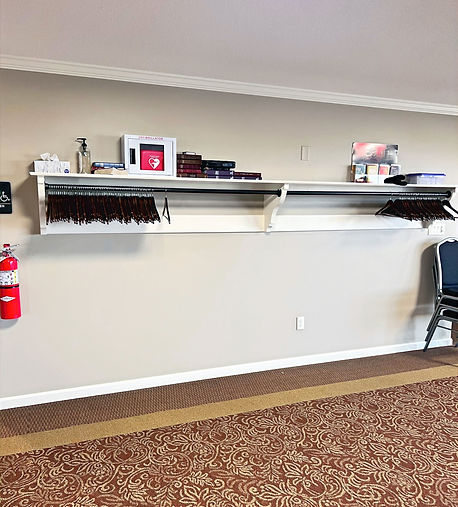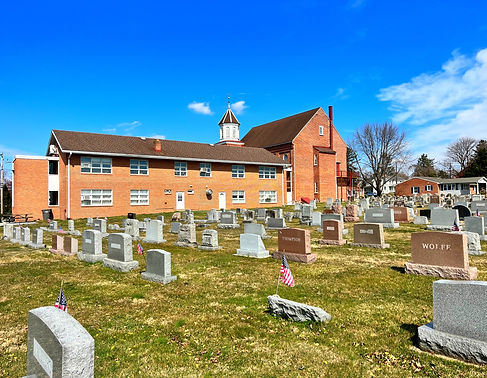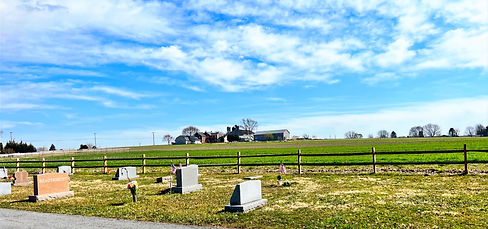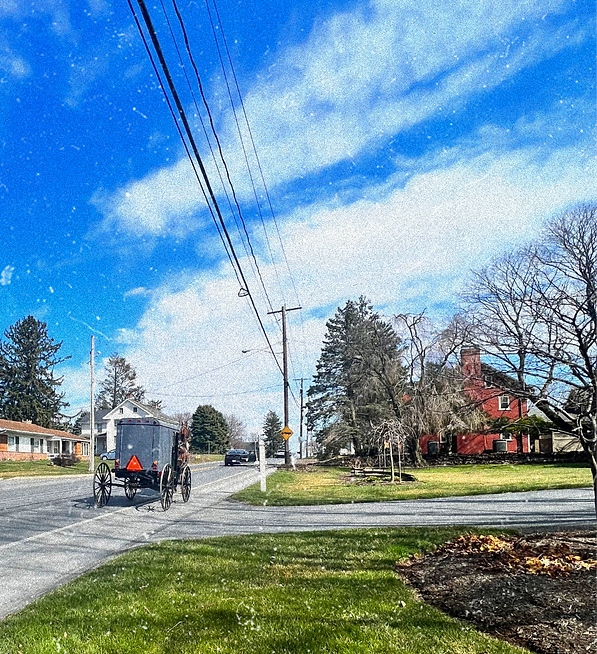The Stoltzfuz family demonstrating the Gregorian Chant. Amish hymns were written, predominantly, in the 16th and 17th centuries, (gathered in a book called the Ausbund,) during a period of persecution against the Anabaptist people. The hymns of The Amish often convey a sense of martyrdom, and the need to remain firm in periods of tribulation. According to Linda Stoltzfuz, this specific chant prepares parishioners for worship, as it creates a grounding sound effect. It has the same frequency of the Earth; 7.83 hertz.




“Thou shalt love the Lord thy God with all thy heart, and with all thy soul, and with all thy mind…Thou shalt love thy neighbor as thyself…” (Matthew 22:37–39)
Top and Bottom Left: The simplicity of the Weavertown Amish Mennonite Church. This church embodies the unpretentious ideals of the Mennonite faith.
Top and Bottom Right: A small cemetery outside the church. Most Amish people are buried in hand-dug graves. A wagon takes the deceased's casket to the cemetery, and four close family members, or friends, are chosen as pallbearers. A final prayer is said at the gravesite, and the deceased's family then throws sod onto the casket. Most tombstones only have engravings of the deceased’s name, birth and death dates, and age. It is, also, not uncommon for graves to be not marked at all. Children’s gravesites are usually unmarked, or have a small flat headstone on the ground. If you look closely, you can see the unadorned, unmarked graves, sprinkled throughout the cemetery.
Strict, Separate, and Proud of It
Nobody practices religion quite like the Amish of Lancaster, Pennsylvania.
“From a religious standpoint, they would emphasize separation from the world,” Dr. Donald Kraybill, a sociology professor at Elizabethtown college, with a concentration in Anabaptist studies.
Originating during the Protestant Reformation of 1517, Anabaptists are a Christian sect that gave way to modern-day Baptists, Amish/Mennonites, and Quakers. The prefix, -ana, meaning “again,” is used in reference to the Anabaptist practice of becoming baptized, only after one is old enough to freely make the decision. Since the founders of this movement had already been baptized as infants, (which is customary in Catholicism) they made the decision to be “again Baptized,” as adults.
Anabaptism was born.
When it comes to matters of business, intermingling with outsiders has become commonplace, and the integration of technology has become a necessary evil. It is, truly, the only way to have a sustainable business in the 21st century, and even the most stringent Amish practitioners have “come to see technology [for business purposes] as something not as bad as they would have told you, say 20 years ago.”
But when it comes to religion, separatism is as alive and strong as ever; something the Amish are unwilling to make any compromise on.
“[Amish people] do not have church buildings. They do not get ministers with a theological education. They don’t have religious services for young people. Church is 2-3 hours, with about 150 people there, including children. No youth Sunday schools. Martin Luther’s German Bible is read, and Pennsylvania Dutch is spoken amongst parishioners. So, as you can see, the way the Amish conduct religious matters remains extremely separatist in nature,” says Kraybill.
Marital matters are religiously influenced as well.
“If an Amish woman falls in love with a non-Amish man, it’s not going to work,” says Kraybill, bluntly.
It is, simply, not acceptable to marry, and raise children with a person who is not Amish. And, if a man or woman wished to convert to the Old Order Mennonite Church, (not to be confused with the Mennonites,) it is extremely uncommon. The Amish do not seek out people to join their religion, and would be very hesitant to bring an outsider into their church.
Amish-Americans are descendants of 17th century founder Jakob Amman. As a result, if you are not a direct descendant of the original German immigrants, who flocked to America in search of religious freedom, it is very difficult to be accepted into the lineage.
However, while the Amish are extremely separatist, especially religiously, “they are not even as strict as they were five or six years ago,” Kraybill says with a laugh.
“The smartphone is so prevalent, and widely used…that the kids do have them. And these devices are addictive. So, when they grow up, and begin to have families of their own, they try to hide/minimize their use as much as they can.”
Kraybill says to think of Amish policy against smartphones/technology like this: “one-third of the Bishops” don’t even blink an eye at smartphones, another third do not practice what they preach, and will “not discipline you for having one,” and the last third “will sometimes excommunicate people for using smartphones, especially, for entertainment purposes.”
What is even more unique about the Amish religion is that it strictly prohibits education past the eighth grade. And, Amish children exclusively attend privately run schools, since the early 1950s, to avoid the distractions of evolving ideas/technologies.
According to the Amish historical site, amishbaskets.com, “The Amish largely view technology as a tool that should be used in moderation, and it should only be used to benefit their way of life. This includes maximizing productivity in agriculture, while adhering to traditional principles like manual labor and simplicity.”
This is because the Amish, (especially, the Old-Order Amish, a faction that is even more traditional in practice,) wish to live in a world, as close to its natural, God-created state, as they can.
Modern technology provides far too many opportunities to stray from their core religious principles of modesty, humility, abstinence, and family.
In other words, anything that can physically, mentally, or metaphorically take their minds away from the pillars of Amish life, (be it a drivers license, an iPhone, or Spotify,) is not allowed.
So, as for that unsanctioned smartphone activity?
Completely self-taught.
These kids have never been exposed to their friends texting their mom, for a ride to Chuck-E-Cheese, or saw a classmate playing Candy Crush at recess.
And, while you may think Amish children possibly resent their families for not allowing them to pursue higher education, interestingly, that is hardly the case.
“These are very smart people. They succeed without high school, and make a lot of money. The Amish are extremely creative, smart, and entrepreneurial. I have rarely come across an Amish person who wishes they went to high school,” says Kraybill.
“In fact, the attitude is, ‘Why would I go to high school when I can make a ton of money running a business?’” he says.
New Order Amish followers are a bit more permissive when it comes to modern-day trappings. They are allowed to use battery-operated lights, and are more likely to use tractors with diesel engines.
Almost all Amish have a landline, usually located in a workshop, or office, to answer business-related calls, or communicate with long-distance family members. However, it is to be used as seldom as possible, and its far-away location serves as a deterrent.
The Mennonites are a different story.
While they dress plainly, their clothes are a bit more colorful than the black and grays that dominate Amish fashion.
Mennonites drive cars as opposed to horse and buggies/scooters, access electricity, can have telephones in their homes, and do not believe in the practice of shunning. Shunning is a common Amish practice in which the entire community completely avoids an excommunicated member of the religion.
It is important to note that Sam Stoltzfuz, a local Amish man, still communicates with a son who has since left Amish life, so this is not a hard-and-fast rule.
Rosalie, a parishioner at Weavertown Amish Mennonite Church, located in Bird-in Hand, P.A., makes the congregation’s weekly bulletin. She only provides her first name.
“Our religion is quite different from that of the Amish,” she explains.
“My family are descendants of the Old Order Amish, but we parted ways many years ago. Firstly, we attend Sunday service in a church, unlike the Amish. Secondly, we have pastors, who lead our services. The Amish do not. Ministers are highly respected members of the community, who have been appointed by us,” she says.
She drives away in her Ford Explorer shortly after our conversation, but not before a quick adjustment of her bonnet.
The differences between these two protestant religions persist, including the use of choirs, and the English language, during Mennonite services, as opposed to the full-bodied vocalizations of the entire Amish congregation, as well as their use of German, when reading scriptures.
A common-thread among both religions is their receival of communion, only twice a year, usually in the fall and spring. Additionally, they are both allowed to vote in elections, and read local newspapers.
However, the biggest link between both religions is their attitude towards giving.
“They feel blessed, and seek to help one another through the hardships life often throws our way. Whether it is a financial, or emotional matter, they are there for their neighbors,” says Kraybill.
"Why would I go to high school?"
